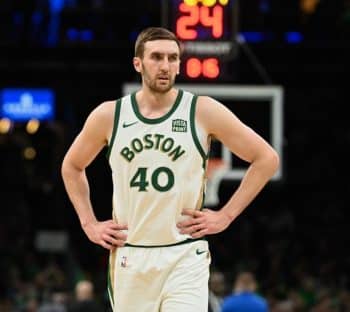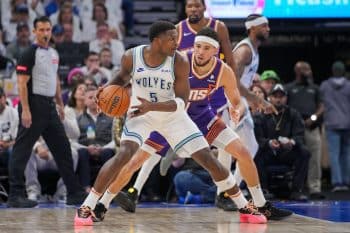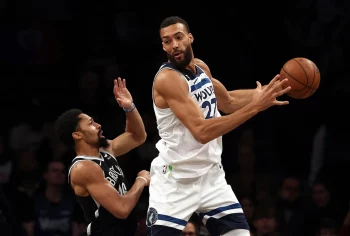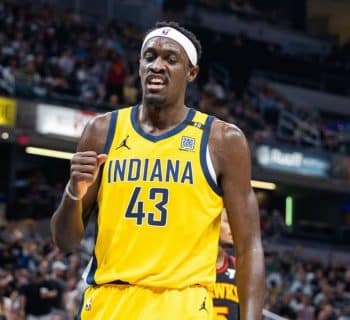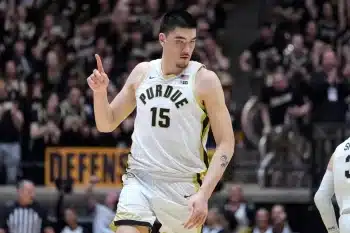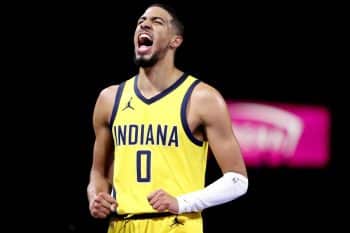NBA
Would Carmelo Anthony Actually Be Miami’s Best Bet?

Typically, analysts and fans don’t begin speculating on the future of an NBA Finals participant until after the series is completed. However, by the midpoint of the 2014 NBA Finals, it was becoming clear the Miami HEAT were no match for the deeper, more complete San Antonio Spurs.
And, perhaps coincidentally, last Wednesday evening, in between Games 3 and 4 of the Finals, an ESPN report surfaced that generated plenty of buzz. The published report indicated that HEAT officials and the team’s “leading players” had already begun exploring ways to lure New York Knicks franchise forward Carmelo Anthony to Miami.
Supposedly a reshuffling in South Beach would begin with LeBron James, Dwyane Wade and Chris Bosh each opting out of their contracts this summer in order to potentially take significant pay cuts and re-sign on new deals that would then allow the franchise to go after Anthony with a enticing offer in hopes of formulating a “Fantastic Four.”
First, we must acknowledge that this scenario seems highly unlikely, primarily because it would require four NBA superstars to all willingly accept far less than market value. Yes, these four men have made a great deal of money in their careers, both on and off the court; however, star players leaving tens of millions of dollars on the table in understandably uncommon.
For example, consider Wade’s situation. He is coming off arguably the worst season of his career. He averaged fewer than 21 points per contest for the first time since his rookie season back in 2003-04. He also had to sit out 28 games during the regular season to rest his surgically repaired knees. He struggled in the postseason as well, as he clearly wasn’t close to 100 percent over the final few games of the Finals. He was inefficient and ineffective on both the offensive and defensive ends of the floor. Wade is a shooting guard who doesn’t shoot three-pointers and has lost much of the athleticism he has relied upon throughout his Hall-of-Fame career.
Wade is owed approximately $41.5 million over the next two seasons. It’s hard to imagine he would opt out this summer, relinquishing that lucrative contract and guaranteed money.
Furthermore, Anthony celebrated his 30th birthday last month, and he is well aware that this will be the final “max-money” contract he’ll be able to secure in his career. If he were to re-sign with New York, he could earn up to $129.1 million over five years with the Knicks. If he signed a max-contract with another team (either Houston or Chicago, for instance) Anthony would be looking at a deal approaching $96 million over four years. Under the “Fantastic Four” scenario, Carmelo would likely have to settle for something in the neighborhood of $60 million (or about $70 million less than a max offer from New York).
And that’s just the financial sacrifice he’d have to make. Would Anthony, a guy who’s been an Alpha Male his entire basketball life, also be willing to play second fiddle in the shadow behind LeBron James, the best player on the planet and arguably the most popular athlete in the world?
Clearly, the odds are stacked against this potential grand plan actually becoming a reality.
However, it must also be acknowledged that in order for the HEAT to reclaim their standing as true championship favorites next season and beyond, Miami does need to make changes. The HEAT weren’t just beaten by the Spurs in the Finals, they were dismantled. Their flaws were exposed for the world to see. More importantly, LeBron was made keenly aware that this roster can not be kept intact. The status quo won’t get it done. And because LeBron can opt-out of his current contract this month, he holds a hammer over the franchise. How will James choose to wield this power? We do know that he, Wade and Bosh are all good friends. How will the bond they have built factor into their individual and communal decisions?
The question remains: Are LeBron and company willing to make substantial monetary sacrifices in order to re-build a better roster? (It should be noted that the Big Three would likely only consider such a scenario if they had a commitment from team owner Micky Arison, the HEAT’s owner, that he would now be willing to pay the luxury tax. This became a major issue in Miami last season.)
One possible resolution might be compromising and meeting in the middle. With Wade, maybe HEAT President Pat Riley could offer an agreement that that Miami would be willing to re-sign him for something in the neighborhood of four years, $42 million if he agreed to opt out of his current deal. Miami would reap short-term benefits because his 2014-15 salary would be cut in half. As for Wade, his annual salary will obviously be reduced, but he’d still get the $40+ million he is guaranteed under the terms of his current contract. Would that be a reasonable conciliation by both parties?
For arguments sake, let’s say James, Wade and Bosh did end up conferring and deciding they are willing to all opt-out and re-sign at a discount. Even if we get to that point, the question then becomes: Would signing Anthony actually be the best allocation of the salary cap savings James and Co. created?
The answer, surprisingly, may be “no.”
One of the primary reasons for Miami’s considerable success this past season, a season in which they finished with the second-best record in the Eastern Conference and advanced to the Finals for the fourth consecutive season, was their offensive explosiveness. The HEAT finished the 2013-14 regular season with the second-best offensive efficiency rating in the NBA, scoring 109 points per 100 possessions. In the postseason, that number increased to 110.5 points/100 possessions. Getting quality shots and putting the ball in the bucket was not an issue. Getting stops on the other end of the floor certainly was.
The HEAT ranked 11th overall in defensive efficiency during the 2013-14 regular season. This marked the first time in the ‘Big Three Era’ that Miami finished the season outside the top-10 in that category. Things only got worse once the postseason began. Miami allowed 108.7 points per 100 possessions during the 2014 playoffs (or slightly more than L.A. Clippers). In Miami’s championship seasons of 2012-13 and 2013-14, they allowed 98.5 and 99.8 points/100 possessions during each respective postseason.
Circling back to Anthony, his strength is obviously his scoring ability. In fact, he is widely considered the second best all-round scorer in the NBA behind only Kevin Durant. Last season, Anthony became just the fourth player in NBA history to average over 27 points a night while shooting above 45 percent from the floor, 40 percent from the field and 82 percent from the free throw stripe. The other three members of that incredibly exclusive club are Larry Bird, Michael Jordan and Durant.
However, the knock on Anthony has always been his suspect defense. He has long been criticized for focusing too intently on his offense and being far too passive on the defensive end.
Part of Miami’s inability to defend at a championship level this past season was due to their lack of an interior presence. Chris “Birdman” Andersen was useful when healthy, but he was dinged up by the end of the year. Former starter Joel Anthony had become a non-factor and was traded (along with a future first-round pick) simply to save money. The Greg Oden experiment failed, as Oden rarely left the pine in the postseason (he was inactive in Game 5 of the NBA Finals). Miami had no true center to patrol the paint. Consequently, Miami finished the season ranked dead last in terms of total rebounds. Ironically, it was Riley who famously once declared: “No rebounds, no rings.”
Another problem that plagued Miami was their lack of depth. It was an issue all season long, and came back to bite them hard in the Finals. The well-rested and balanced Spurs ran circles around Miami. The Spurs’ reserves, which led all teams in the regular season with over 45 points per game, outscored the HEAT’s second unit by nearly 15 points per game. In terms of ‘plus-minus,’ San Antonio’s bench players were an incredible +91 while Miami’s were an awful -81.
No player was more negatively affected by Miami’s insufficient depth than LeBron. The reigning league MVP and Finals MVP was forced to carry far too much of the load during the regular season. Ideally, Erik Spoelstra would have been able to manage and limit LeBron’s minutes during the season just as Gregg Popovich did with Tony Parker, Manu Ginobili and Tim Duncan. However, it was simply not an option. LeBron played a total of 3,665 minutes this past season. In contrast, Duncan, who led the Spurs in minutes, played 755 fewer total minutes (2,910).
As noted above, Wade missed 28 games during the regular season, and still wasn’t able to finish the postseason with a flourish. In addition, the HEAT didn’t have any realistic options off the bench to provide LeBron with much-needed rest throughout the dog days of January, February and March. (This was partially the result of Mike Miller being amnestied prior to the start of the season in an effort by the owner to avoid the luxury tax.) All the HEAT had to offer free agents last summer were contracts at the veteran’s minimum. Thus, Riley was forced to roll the dice on guys like Oden and Michael Beasley. Too many worn out vets and not enough effective role players capable of providing solid minutes was a recipe for disaster.
Without a well-balanced roster, Miami was forced to rely too heavily on the Big Three, which was more akin to a ‘Big 1.5’ in the Finals. Lacking the youthful, energetic legs required to provide a spark, the HEAT had finally run out of gas. San Antonio simply sprinted by them and reached to the finish line first, while an exhausted Miami squad was left gasping for air.
LeBron dragged his team as far and fast as he could, but it was clearly not enough.
The moral of the story is that Miami obviously has flaws they need to address. But is another offensive-minded, ball-dominant forward exactly what the doctor ordered? If the ‘Big Three’ morphs into the ‘Fantastic Four,’ Miami’s strengths will be strengthened, but their biggest needs (defense, depth, athleticism, and youth) won’t be significantly improved.
With James, Wade, Bosh and Anthony on the same squad, Riley will once again be forced to flesh out the roster with players making the minimum. Can they find a reliable point guard willing to play for less than $2 million per season? Is there a strong, solid starting center willing to settle for the vet’s minimum?
The team that obliterated the HEAT this month wasn’t overly reliant on one player. Spurs General Manager R.C. Buford and Coach Pop constructed a balanced roster, with role players that were content to serve as complimentary pieces to the team’s stars.
Is there a lesson to be learned here?
What if James, Wade and Bosh remained committed to taking less and carving out extra cap space, but instead of bringing in Anthony, they decided to spread that wealth around a bit?
For instance, what if Miami targeted a combination of unrestricted free agent point guard Kyle Lowry and center Marcin Gortat?
Lowry is a versatile and gifted point guard, who is coming off the best season of his career. He played terrifically during the regular season and even better in the playoffs. Lowry would actually be the best point guard that James has ever played with in his 11-year NBA career.
Gortat would be the rebounding and rim-protecting big man Miami coveted all season long. He’s averaged 15 points, 10.5 rebounds and 1.7 blocks per-36 minutes over the last three seasons.
A starting five of Lowry, Wade, James, Bosh and Gortat would be far less dependent upon LeBron at both ends of the floor.
Still, both Lowry and Gortat would likely have to accept less than market value (depending on how little James, Wade and Bosh re-signed for), but it is an option certainly worth exploring, no?
Furthermore, that’s obviously not the only combination Miami could consider.
What about free agent point guard Isaiah Thomas and big man Pau Gasol?
What about making a run at restricted free agent (and LeBron’s good friend) Eric Bledsoe?
Other, more affordable centers and guards on the market this summer include Spencer Hawes, Avery Bradley, Shaun Livingston, Josh McRoberts, Rodney Stuckey, Andray Blatche, Channing Frye, Greivis Vazquez, Ramon Sessions, Kirk Hinrich, Darren Collison, Kris Humphries, Patty Mills and Chris Kaman.
There are plenty of permutations possible, a multitude of way to slice up $16+ million.
Obviously, no combination of these names would make the splash or generate the same buzz as Anthony, but that doesn’t necessarily mean it would be a better overall fit for the HEAT.
